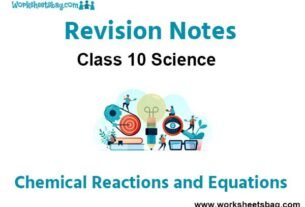Please refer to the Light Reflection and Refraction Revision Notes given below. These revision notes have been designed as per the latest NCERT, CBSE and KVS books issued for the current academic year. Students will be able to understand the entire chapter in your class 10th Science book. We have provided chapter wise Notes for Class 10 Science as per the latest examination pattern.
Revision Notes Chapter 10 Light Reflection and Refraction
Students of Class 10 Science will be able to revise the entire chapter and also learn all important concepts based on the topic wise notes given below. Our best teachers for Grade 10 have prepared these to help you get better marks in upcoming examinations. These revision notes cover all important topics given in this chapter.
• Light is a form of energy which is used to see any object by sensitizing our sense of vision.
• Reflection of light -The bouncing back of light when it strikes a smooth or polished surface is called reflection of light.
• Laws of reflection of light
1. Angle of incidence(i) is equal to the angle of reflection(r).
2. The incident ray, the reflected ray and the normal at the point of incidence lie in the same plane.

Mirror- A sheet having one surface reflecting and other polished with silver is called a mirror. It is mainly of two types
1. Plane mirror 2. Spherical mirror
• Plane mirror-Mirror having plane reflecting surface is called plane mirror.
• Spherical mirror-Mirror having spherical reflecting surface is called spherical mirror. It is a part of hollow sphere made of glass or plastic. It is of two types:
Concave mirror – A spherical mirror having its reflecting surface towards the centre of sphere of which it is a part, is called concave mirror.
Convex mirror – A spherical mirror having its reflecting surface away from the centre of sphere of which it is a part., is called convex mirror.

Terms related to the mirror
• Centre of curvature-It is the centre of the sphere of which mirror is a part and is denoted by ‘C’.
• Radius of curvature- It is the radius of the sphere of which mirror is a part and is denoted by ‘R’.
• Pole -It is the middle point of the mirror, denoted by ‘P’.
• Principal axis -It is the line that joins centre of curvature and pole.
• Principal Focus- The rays of light parallel to the principal axis of the mirror after reflection either pass through a point (in case of concave mirror) or appear to come from a point (convex mirror), the point is known as focus or principal Focus, denoted by ‘F’.

• Focal length- The length between focus and pole of the mirror is focal length. It is denoted by ‘f’.
• Aperture -The diameter of the reflecting surface of the mirror is called aperture.

Image- If light rays coming from a point after reflection meet at another point or appear to meet at another point, then second point is called the image of first point. There are two types of image, i.e.
(i) Real image- If the light rays coming from a point actually, meet after reflection, then the image formed is called a real image.
(ii) Virtual image -If the light rays coming from a point, after reflection do not actually meet, but appear to meet at a point when produced backwards then the image formed is called a virtual image.
Note- 1. Focal length is half of the radius of curvature. f=R/2
2. Object is always placed left side of the mirror.
Rules for drawing ray diagrams
1. Light ray parallel to the principal axis passes through the focus after reflection from the mirror.
2. Light ray passing through the centre of curvature get reflected on the same path.
3. Light ray passing through the focus becomes parallel to the principal axis after reflection.
4. A ray incident obliquely to the principal axis, towards a point P (pole of the mirror), on the concave mirror or a convex mirror, is reflected obliquely
Image formation by Concave Mirror
(i) When object is at infinity
Image Position − At ‘F’
Nature of image – Real, inverted
Size – Point sized or highly diminished

(ii) When object is beyond ‘C’
Image Position – Between ‘F’ and ‘C’
Nature of image – Real, inverted
Size – Diminished

(iii) When object is at ‘C’
Image Position – At ‘C’
Nature of image – Real, inverted
Size – Same size as that of object

(iv) When object is placed between ‘F’ and ‘C’
Image Position – Beyond ‘C’
Nature of image – Real, inverted
Size – Enlarged

(v) When object is placed at ‘F’
Image Position – At Infinity
Nature of image – Real, inverted
Size – Highly enlarged

(vi) When object is between ‘P’ and ‘F’
Image Position – Behind the mirror
Nature of image – Virtual, erect
Size – Enlarged




